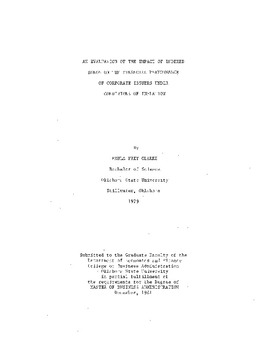| dc.contributor.advisor | Jackson, James F. | |
| dc.contributor.author | Clarke, Paula Frey | |
| dc.date.accessioned | 2016-05-20T20:33:30Z | |
| dc.date.available | 2016-05-20T20:33:30Z | |
| dc.date.issued | 1981-12 | |
| dc.identifier.uri | https://hdl.handle.net/11244/34761 | |
| dc.description.abstract | Scope and Method of Study: A simulation model which generates income statements and balance sheets was used to study the impact that both indexed and non-indexed debt would have on the financial performance of a hypothetical firm over a ten-year period. Thirty-six scenarios were developed in which the. Primary variables altered were the type of debt used in the firm's capital structure (bonds with indexed interest only, bonds with indexed principal only, bonds with indexed interest and principal, traditional long-term bonds, and short-term debt), and the direction of change in the inflation rate (increasing decreasing, constant, or random). Income statements and balance sheets were generated for each scenario from which selected measures for three areas of financial performance were calculated: cash flow, profitability, and risk. Measures for the cash flow analysis included annual interest expense (indexed and non-indexed), principal repayment (with and without a sinking fund), and total cash flow (interest plus principal). A hypothetical price index was used to adjust indexed interest and/or principal. Measures for profitability analysis included return on investment, return on net-worth, and net profit margin. Measures for risk analysis included coverage ratios (times interest earned and fixed charge coverage), debt ratios (total debt~ total assets and total debt~ net worth), and statistical measures (mean, variance, and standard deviation of earnings per share). | |
| dc.description.abstract | Findings and Conclusions: Traditional non-indexed bonds and those with only the, interest indexed were consistently found to be the most beneficial debt instruments for the firm to use during any inflation conditions. The firm would naturally prefer to use traditional, fixed-rate debt (except during decreasing inflation when indexed interest bonds would decrease cash flow and increase profitability), but during rapidly rising inflation this option is not always available as investors will not lend funds for a fixed-return for the long-term. When indexing is chosen as an alternative source of funds, then bonds with only the interest indexed provide the most beneficial impact on all areas of financial performance. Bonds which include an indexed principal feature were found to significantly increase the demand on the firm's cash, annually if a sinking fund is used and only at maturity if a sinking fund is not used. More default risk was added to the firm's capital structure using indexed principal bonds since the liability becomes larger each year during any inflation conditions as long as the inflation rate is greater than zero. Return on investment was the only area of profitability affected by these bonds. The exclusive use of short-term debt was found to be the least beneficial to the firm in all areas of performance under any inflation conditions. All findings and conclusions are subject to the constraints of the model. | |
| dc.format | application/pdf | |
| dc.language | en_US | |
| dc.rights | Copyright is held by the author who has granted the Oklahoma State University Library the non-exclusive right to share this material in its institutional repository. Contact Digital Library Services at lib-dls@okstate.edu or 405-744-9161 for the permission policy on the use, reproduction or distribution of this material. | |
| dc.title | Evaluation of the impact of indexed bonds on the financial performance of corporate issuers under conditions of inflation | |
| osu.filename | Thesis-1981R-C599e.pdf | |
| osu.accesstype | Open Access | |
| dc.type.genre | Master's Report | |
| dc.type.material | Text | |
| thesis.degree.discipline | Finance | |
| thesis.degree.grantor | Oklahoma State University | |
